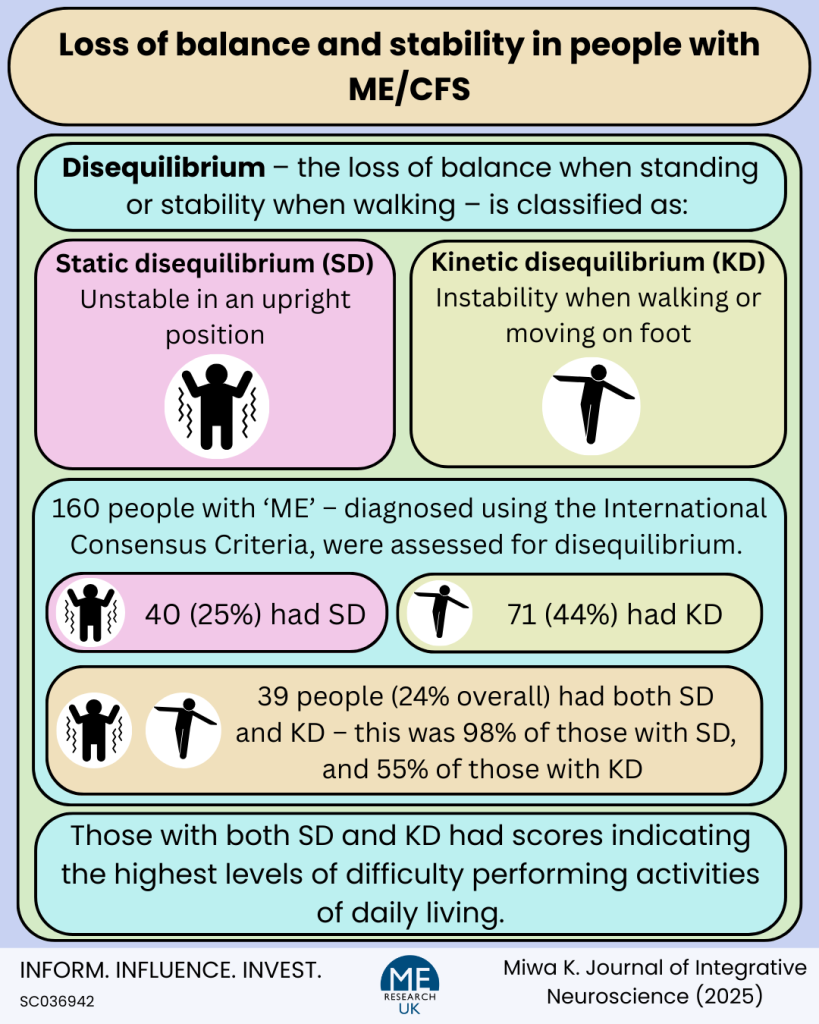Research has suggested that people with ME/CFS may have postural instability or ‘disequilibrium’ – loss of balance when standing or stability when walking.
Disequilibrium is classified as ‘static’ – unstable in an upright position, or ‘kinetic’ – instability when walking or moving on foot.
Interestingly, disequilibrium associated with any form of dizziness or vertigo related to the functions in the brain which process balance information has been linked to orthostatic intolerance – the experience of unusual symptoms, such as dizziness or feeling faint, after standing that are relieved by reclining. Notably, evidence suggests that orthostatic intolerance may be more common in people with ME/CFS than those without the disease.
Research published by scientists in Japan found that a non-invasive treatment called ‘repetitive transcranial magnetic stimulation’ (rTMS) relieved symptoms of static disequilibrium and orthostatic intolerance in people with ME/CFS. However, this study did not consider kinetic disequilibrium.
Therefore, the team conducted another study – published in the Journal of Integrative Neuroscience, which investigated both static and kinetic disequilibrium in people with ME/CFS, and looked at the potential therapeutic benefit of rTMS.
What did the researchers do?
160 people (Criteria 53 males and 107 females) with ‘ME’ – diagnosed using the International Consensus Criteria, were tested for static and kinetic disequilibrium.
Static disequilibrium test:
- Participants were asked to stand with their feet together and eyes closed for 10 seconds.
- Unstable standing or movement of the body in a forward and backward direction, and a ‘to and fro’ motion indicated static disequilibrium.
Kinetic disequilibrium test:
- Participants were tasked with carefully walking 2 metres on a straight, flat floor, completing toe-to-heel touch with each step – at the end of the 2 meters, the participants were then asked to turn and return using the same method of walking.
- Step–out, misstep, and/or body sway with displacement of the head were deemed to indicate kinetic disequilibrium.
Participants were also assessed for fibromyalgia using “The American College of Rheumatology 1990 Criteria”, and for orthostatic intolerance using the 10 minute active stand test. The chalder fatigue scale was used to assess levels of fatigue, and information relating to activities of daily living was collected from participants and verified by a physician – this was graded on a 10-point scale and called ‘performance status’.
Participants with static and kinetic disequilibrium were invited to take part in a study to investigate whether rTMS would improve the disequilibria they were experiencing.
What did the study find?
Static disequilibrium was found in 25% (40) of people with ME. Compared to people with ME who did not have static disequilibrium, those with:
- Had significantly longer duration of ME
- Had scores indicating higher levels of fatigue.
- Had scores indicating more difficulties performing activities of daily living.
- Were more likely to also have fibromyalgia.
- Were more likely to have orthostatic intolerance.
Kinetic disequilibrium was identified in 44% (71) of the participants with ME. Compared to people with ME who did not have kinetic disequilibrium, those with:
- Were significantly more likely to be female.
- Had scores indicating higher levels of fatigue.
- Had scores indicating more difficulties performing activities of daily living.
- Were more likely to also have fibromyalgia.
- Were more likely to have orthostatic intolerance.
The researchers reported that 39 people had both static and kinetic disequilibrium – this was 98% of participants with static disequilibrium, and 55% of participants with kinetic disequilibrium. Notably, those with both static and kinetic disequilibrium had scores indicating the highest levels of difficulty performing activities of daily living.
13 participants underwent rTMS, 85% (11) showed “recovery from static and kinetic disequilibrium following the treatment”.
Interestingly, 8 (89%) of the 9 participants with orthostatic intolerance prior to rTMS, no longer had it following the treatment.
What do the findings mean?
Results suggested that in this group of participants with ME, static and kinetic disequilibrium were common and associated with both increased fatigue levels and difficulty completing activities of daily living.
Static and kinetic disequilibrium were alleviated in most people with ME following rTMS treatment. This finding is something that the researchers suggest indicates involvement of the system responsible for maintaining balance and spatial orientation – the central vestibular system (this consists of the vestibular nuclei in the brainstem, the cerebellum, and their connections in the nervous system).
Potential limitations of the study
- There was no control group in this study meaning it is impossible to tell whether similar levels of static and kinetic disequilibrium would be observed in those without ME/CFS – and whether the rTMS treatment would be beneficial to those in the control group who did display disequilibrium.
- Although the overall sample size for this study was 160 people, only a very small number (13) underwent rTMS. This small sample size is not large enough to allow any firm conclusions to be drawn about whether rTMS may be an effective treatment for static and kinetic disequilibrium, and for orthostatic intolerance.
- This study did not consider the long-term effects of rTMS.
Conclusions
The results from this study suggest that some people with ME/CFS experience static and/or kinetic disequilibrium which have been linked with orthostatic intolerance.
Participants with both static and kinetic disequilibrium had scores indicating the highest levels of difficulty performing activities of daily living.
rTMS may provide a treatment to alleviate symptoms of disequilibrium in people with ME/CFS, however more research is needed which compares results for people with ME/CFS with those for a control group, and considers the impact of rTMS over time.





